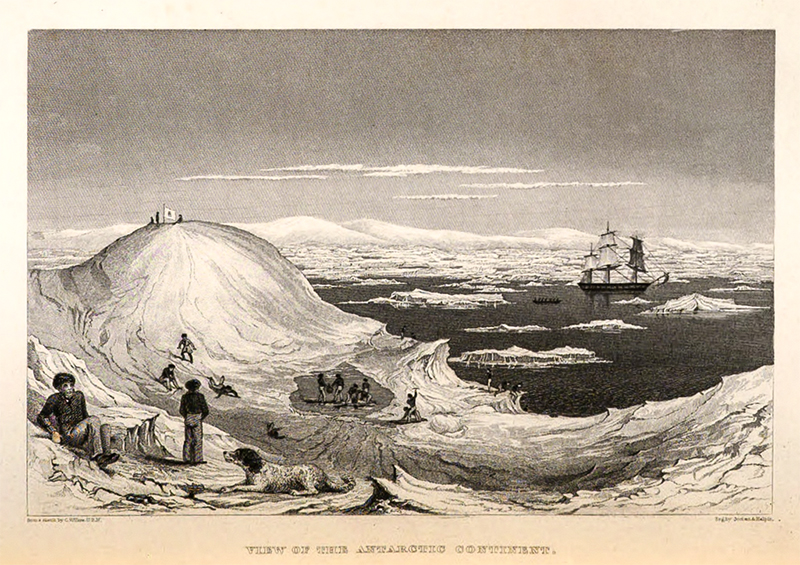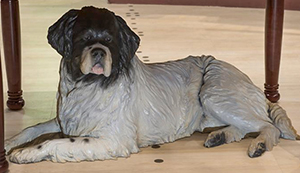[ Wilkes / Narrative of the United States Exploring Expedition ]
Wilkes (1798 - 1877) was a Rear Admiral in the United States Navy, and one of his signal accomplishments during his long naval career was to head the Unites States Exploring Expedition of 1838 - 1842, often referred to as the "Wilkes Expedition," which circumnavigated the globe on a scientific, cartographic, and exploratory mission that logged 87,000 miles. His survey mission also brought him into conflict with native peoples in various parts of the world, most of whom he viewed with racist disdain and sometimes treated horribly. Upon his return he was court-martialed for excessively punishing his crew, though he was acquited of most charges. He was also court-martialed later in his career, mainly for disobeying orders and insubordination due to a public feud with the Secretary of the Navy over a promotion. While he was an accomplished naval leader, his at-times arrogant and abrasive manner and often-poor treatment of his crew has led some historians to suggest he was the model for Captain Ahab in Herman Melville's Moby Dick.
The 5-volume official account of the expedition, written by Wilkes, was first published in 1844.
Wilkes is of interest here because the Exploring Expedition had, among its crew members, a Landseer Newfoundland named Sydney. Who, it is worth mentioning, is yet another Newf who has been honored with a statue; his resides in the Smithsonian National Air and Space Museum. Learn more about it at this page here at The Cultured Newf.
Wilkes' first mentions the dog in Volume 3. (Wilkes acquired the Newf from the governor of Australia — hence the dog's name — when the expedition stopped there for provisions, which is why the dog has not appeared earlier in the official account.) This first mention of the dog is occasioned by a visit to the expeditions's flagship when the boats dropped anchor at Fiji; several important local figures, including a prominent chief named Tanoa, had been invited aboard:
On the following morning, when the boat landed, the three chiefs were waiting on the beach, and all came on board, the large canoe following the boat; every thing was prepared to give them a most marked reception, excepting the salute. Tanoa was the first to mount the side of the ship, where I was ready to receive him, with the officers at the gangway. When he reached the deck, he was evidently much astonished, particularly when he saw the marines, with their muskets, presenting arms, and so many officers. The novel sight, to him, of my large Newfoundland dog, Sydney, who did not altogether like the sable appearance of his majesty, the noise of the drum and boatswain's pipe, combined to cause him some alarm, and he evinced a disposition to retire, keeping himself close to the ship's side. (III: 55 - 56)
The above incident is also included, verbatim, in Wilkes' condensed, one-volume version of the Narrative, entitled Voyage Round the World, Embracing the Principal Events of the Narrative of the Exploring Expedition, first published in 1849.
Wilkes recounted this story a second time in his Autobiography, written in 1871 but not published until 1978. You can check it out here at The Cultured Newf.
Sydney is next mentioned in volume 4, when Wilkes recounts the experience of two crew members' descent into the crater of the Mauna Loa volcano in Hawaii.
To the bottom of the crater, there was a descent at the northwest angle of the black ledge, where a portion of it had fallen in, and afforded an inclined plane to the bottom. This at first appeared smooth and easy to descend, but on trial it proved somewhat difficult, for there were many fissures crossing the path at right angles, which it was necessary to get over, and the vitreous crust was so full of sharp spinulae as to injure the hands and cut the shoes at every step. Messrs. Waldron and Drayton in their descent were accompanied by my dog Sydney, who had reached this distance, when his feet became so much wounded that they were compelled to drive him back; he was lamed for several days afterwards, in consequence of this short trip into the crater. (128)
That's it for mentions of Sydney by his owner, Adm. Charles Wilkes. The dog gets mentioned a couple of times in Wilkes' Autobiography, which neglects the crater story but makes some general comments on Sydney's helpfulness to the expedition; check it out here.
Unfortunately, we never learn Sydney's fate — he simply disappears from the record, not unlike Merriweather Lewis' Seaman.
Yet Wilkes was not the only member of the expedition who wrote about Sydney the Newf. One of the sailors, Charles Erskine, later wrote Twenty Years Before the Mast (1890) about his life as a sailor, including his time with the Unites States Exploring Expedition. Check it out here at The Cultured Newf.
 Wilkes' own sketch of "the Antarctic continent" includes Sydney in the foreground.
Wilkes' own sketch of "the Antarctic continent" includes Sydney in the foreground.

